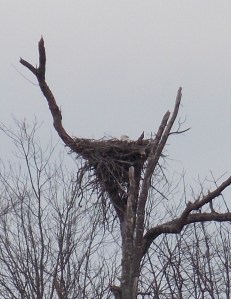Today I was fortunate enough to have a meeting for work in the small city of Linton. For those of you not familiar with Indiana birding locations, Linton is the home of the Goose Pond Fish and Wildlife Area, also known as Magical Bird Wonderland and the state’s premier birding location not located on Lake Michigan. I made sure to arrive at the meeting extra early to get in some quality birding time. Despite the driving rain, it was a more than great day!
If Indiana does one bird well, it is the Sandhill Crane, and Goose Pond does the Sandhill Crane very well. Since its establishment, Goose Pond has actually altered the migration route of these birds, causing massive swarms of the four-foot-tall beasts to gather there in the winter. There were literally thousands, if not tens of thousands of cranes. They covered the corn stubble fields, grazing like massive herds of avian cattle. They passed overhead in wave after wave of unending V’s. The cranes here may actually be the most incredible natural phenomenon I have ever seen, and a highly worthy year bird #054
Also among the impressive flocks of birds was the continuing mass of American White Pelicans that had taken over many of the muskrat lodges in the main pool. These are a rarity in Indiana at this time of year, giving me a very good year bird #056. Not that #055 Common Grackle wasn’t also good, but I will probably not be seeing pelicans every day this spring and summer in my neighborhood.
The waterfowl kept coming with several species of ducks, many of which were lifers for me. Redheads were year bird #058 as well as life birds. I came home to show Jaime my photos, and the first thing she said was “Redheads!” I told her I was impressed that she knew the name of them, only to be informed that she was just talking about their red heads. This is an appropriately named duck.
Year bird #059 was the Ring-Necked Duck pictured above (the male is the top center bird in the photo). A few of these small ducks were hanging out in a large group of Redheads, Lesser Scaups, and Gadwalls on a very small pond.
Here is one of the aforementioned Lesser Scaup. In addition to being year bird #060 (which was my target number to get to today), they were also life birds.
The last bird I was able to identify was the humble Gadwall (bottom center bird above). Year bird #061 (putting me over my goal) and yet another lifer as well.
For those of you keeping track at home, you may have noticed that I skipped year bird #057. That is because I didn’t get a picture of them. However, as I was marching to the duck pond to take photos, I accidentally flushed a flock of Sandhill Cranes that was out of sight over a rise. As the birds lifted off, I saw three large white forms fly away with them. My heart literally skipped a beat as I thought “Whooping Cranes!” The total global population of Whooping Cranes is only in the triple digits, so they would have been a very exciting sight. Their rarity also contributed to my not seeing them, because the white birds in question turned out to be Snow Geese. Still exciting for me, though, because they were lifers! I ended the day with a life list of 192 species.
Goose Pond was incredibly impressive, despite the stormy weather and the fact that I missed many of the most impressive migrating flocks of waterfowl (sadly missing from my day list were Greater White-Fronted Geese and Northern Pintail). I will definitely try to make another trip back here some time despite the distance, and I will recommend that if you are even in the vicinity of southwest Indiana, Goose Pond is well worth a visit.















